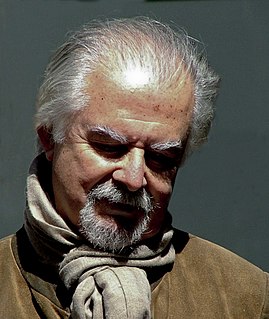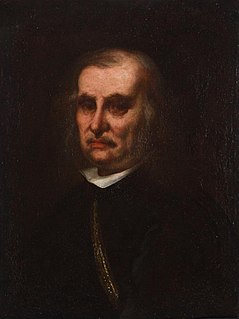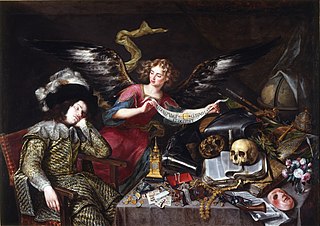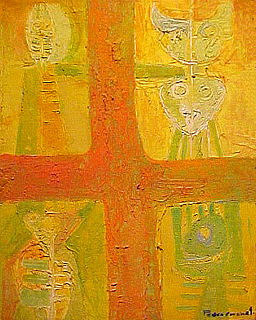This article has multiple issues. Please help improve it or discuss these issues on the talk page . (Learn how and when to remove these template messages)
|
Pedro Pedraja (born 1974) is a Spanish painter living in Great Britain. [1] [2]
This article has multiple issues. Please help improve it or discuss these issues on the talk page . (Learn how and when to remove these template messages)
|
Pedro Pedraja (born 1974) is a Spanish painter living in Great Britain. [1] [2]
He is originally from Santander, Spain. He is a graduate of The University of the Basque Country (UPV) in Bilbao, where he studied from 1997 to 2002. [2]
In the 2004 Liverpool Biennial, Pedraja was selected to take part in the John Moores 23 exhibition of contemporary British painting at the Walker Museum. [3] He exhibited at The Royal Academy of Arts in London – RA Summer Show 2006.
His work has been exhibited at the Doncaster Museum and the Eduardo Chillida Centre in Madrid.

Fernando Botero Angulo is a Colombian figurative artist and sculptor, born in Medellín. His signature style, also known as "Boterismo", depicts people and figures in large, exaggerated volume, which can represent political criticism or humor, depending on the piece. He is considered the most recognized and quoted living artist from Latin America, and his art can be found in highly visible places around the world, such as Park Avenue in New York City and the Champs-Élysées in Paris.

Joaquín Sorolla y Bastida was a Spanish painter. Sorolla excelled in the painting of portraits, landscapes and monumental works of social and historical themes. His most typical works are characterized by a dexterous representation of the people and landscape under the bright sunlight of Spain and sunlit water.

Benito Quinquela Martín was an Argentine painter. Quinquela Martín is considered the port painter-par-excellence and one of the most popular Argentine painters. His paintings of port scenes show the activity, vigor and roughness of the daily life in the port of La Boca.

Juan Soriano was a Mexican artist known for his paintings, sculptures and theater work. He was a child prodigy whose career began early as did his fame with various writers authoring works about him. He exhibited in the United States and Europe as well as major venues in Mexico such as the Museo de Arte Moderno and the Palacio de Bellas Artes. His monumental sculptures can be found in various parts of Mexico and in Europe as well. Recognitions of his work include Mexico's National Art Prize, the Chevalier des Arts et Lettres and membership in France's Legion of Honour.

Juan Carreño de Miranda was a Spanish painter of the Baroque period.

Félix de la Concha is a painter. Born in León, Spain, he resides in Pittsburgh and Madrid.
Miguel Condé is a Mexican figurative painter, draughtsman, and print maker. According to Radio France, he is "one of the most important contemporary masters in the field of engraving." Condé's works are in important museum collections all over the world; he is exhibiting regularly at both public and private venues, and he has received numerous international honors and awards.
Pablo Palazuelo was a Spanish painter and sculptor.

KCHO, born Alexis Leiva Machado on the Isla de Pinos (1970), is a contemporary Cuban artist. Kcho has had art showings around the world. He first attracted international attention by winning the grand prize at South Korea's Kwangju Biennial in 1995.

Antonio de Pereda y Salgado was a Spanish Baroque-era painter, best known for his still lifes.

Pedro Coronel was a Mexican sculptor and painter, part of the Generación de la Ruptura, bringing innovation into Mexican art in the mid 20th century. Coronel’s training was with artists of the Mexican muralism tradition, with influence from artists like Diego Rivera. This influence remained with the use of pre Hispanic themes and colors in his work. However, his artistic trajectory took him towards more use of color and more abstract forms in his work, due to influences from artists such as Rufino Tamayo. His work was exhibited and gained recognition in Mexico, the United States and Europe. Shortly before his death, he donated his considerable personal art collection to the people of Mexico, which was used to open the Museo Pedro Coronel in the city of Zacatecas.
Oscar Mariné Brandi is a designer, illustrator, expert typographer and professional artist; Oscar Mariné is one of the major communicators in post-Franco Spain. His internationally renowned work includes iconic designs for filmmakers like Pedro Almodóvar, Alex de la Iglesia, and Julio Médem, musicians like Bruce Springsteen, The Psychedelic Furs or Brian Eno, the press and a variety of firms He is the founder of OMB Graphic Design studio in Madrid.

Antón Lamazares is a Spanish painter, who is, along with José María Sicilia, Miquel Barceló and Víctor Mira, a member of the "generación de los 80". Working elaborate surfaces of wood and cardboard with varnish and other materials, he has created a very personal medium and artistic language. From an initially playful expressionism, his style has developed toward abstract expressionism and straightforward abstraction, and, more recently, a sort of minimalism in which an intimate dialogue between soul and memory, the spiritual and the sensual, poetry and dream-life can take place. His works have been exhibited throughout the world and are held by numerous important institutions, including the National Museum Reina Sofía, the Galician Centre for Contemporary Art, the Madrid Museum of Contemporary Art and the Marugame Hirai Museum of Japan, as well as by many private collectors and foundations.
Pablo Serrano Aguilar, was a Spanish abstract sculptor.
Jesus Fuertes was a Cubist painter, who was initiated into the world of art by Salvador Dalí, and was described as a "true genius" by Pablo Picasso. Fuertes often chose women and cats as his subject matter. Several of his well-known works involve the use of shades of blue, which earned him the nickname "Painter of Blue".

The Museo Estatal de Arte Popular de Oaxaca or MEAPO is a small museum in the municipality of San Bartolo Coyotepec just south of the city of Oaxaca in Mexico. It is run by the state of Oaxaca to showcase the entity's handcrafts and folk art tradition, through its permanent collection, online “cyber-museum,” collaboration with national and international entities, and sponsorship of events such as craft markets, conferences, and temporary exhibitions. It is dedicated to the crafts and to the artisans and the cultures behind the items. Its collection contains samples of most of the crafts produced in the state, especially the Central Valleys region, but most of its collection consists of barro negro pottery, the specialty of San Bartolo Coyotepec. It is run by director Carlomagno Pedro Martínez, a recognized artisan and artist in barro negro.
Antonio Rodríguez Luna was a Spanish painter who developed most of his career while in exile in Mexico during the Spanish Civil War. He began his career young, while still studying in Madrid and before the war had already exhibited in various places in Europe. His opposition to Francisco Franco, forced him into exile, with intellectuals and artists in the country arranging his asylum. His career here included a Guggenheim Fellowship with major exhibitions in Washington DC and New York along with exhibitions at the Museo de Arte Moderno and the Palacio de Bellas Artes in Mexico. Despite his success, he never forgot his Spanish roots, with an exhibition in Madrid in 1971 and a return to his hometown of Montoro in 1981, after the death of Franco.

Daniel Garbade is a Swiss painter, illustrator, art director, property master, and publisher. Born in Switzerland from Swiss-Cuban origins, Garbade is the grand-nephew of Adrien Lachenal, great-grandchild of Cuban sculptor Fernando Heydrich, grandson of Theodore Garbade and cousin of sculptor Juan Esnard Heydrich.

Plácido Maria Martin Zuloaga y Zuloaga was a Spanish sculptor and metalworker. He is known for refining damascening, a technique that involves inlaying gold, silver, and other metals into an iron surface, creating an intricate decorative effect. Zuloaga came from a family of Basque metalworkers. He was the son of damascening pioneer Eusebio Zuloaga, the half-brother of the artist Daniel Zuloaga, and the father of the painter Ignacio Zuloaga. Taking over his father's armaments factory, he adapted it to make art pieces which he exhibited at international fairs, winning multiple awards.
Alberto Corazón Climent was a Spanish multidisciplinary artist who combined graphic design, sculpture, painting, and photography into his works. Some of his works are housed at contemporary museums including Bilbao Fine Arts Museum, Museum of Contemporary Art, Madrid, and Institut Valencià d'Art Modern. He worked as a graphic designer for clients including the organizations National Library of Spain, Autonomous University of Madrid, Anaya, ONCE, Círculo de Bellas Artes, and Renfe Operadora. He was inducted as the member of the Real Academia de Bellas Artes de San Fernando in 2006.